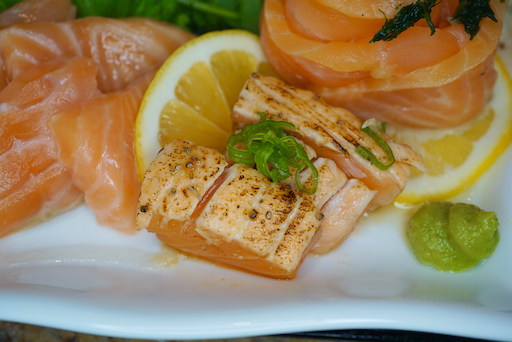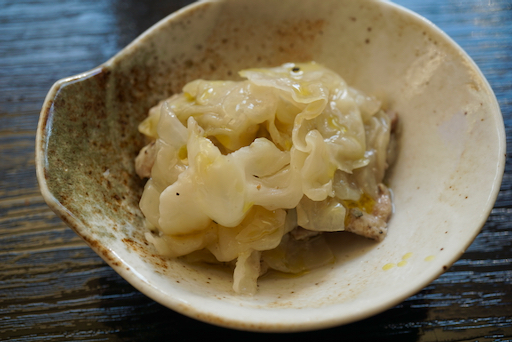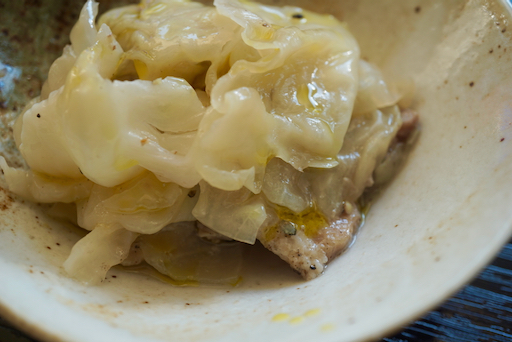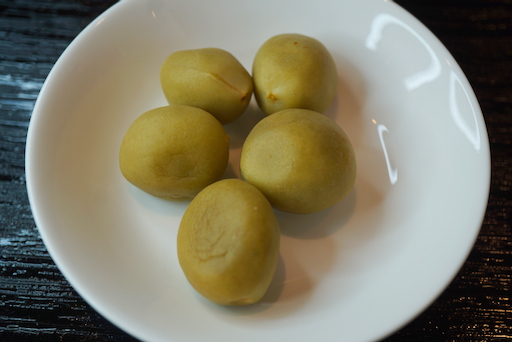When
our refrigerator went kaput, some of the Japanese frozen items thawed almost completely. One of them was "Abura-age" 油揚げ or deep fried tofu pouches. These were rectanglar-shaped full sized ones called "
Ganko-oyaji-no-abura-age" がんこおやじの油揚げ (meaning "stubborn old man's abura-age*"). I decided the best way to save them was to cook them in soy sauce and sugar or/or mirin which is called "Ama-Kara" 甘辛 meaning "sweet and salty". Once cooked, they would last longer and also could also be used to make "
Inari-sushi" 稲荷寿司 (right below) and "Kitsune udon" 狐うどん (left below) which I did a week or so later and served as a lunch one weekend. I served Inari-sushi (or more accurately, Inari-zushi) with cucumber "asazuke" 浅漬け and sweet vinegar-dressed ginger (store-bought).
*This is a Japanese way of saying that this product was made with a stubborn determination of an old man who upholds a tradition of making the best product without any compromises.
Classically, Kitsune Udon is simply topped with seasoned abura-age and chopped scallion (this is a famous dish in Osaka 大阪 and they typically used the green part of the scallion as opposed to Tokyoites who uses only the white part. Since I made home pasteurized eggs in that morning, I added a poached egg as well. That makes this as "Kitsune Tsukimi udon" キツネ月見うどん. "Tsukimi" 月見 means "moon gazing" and the egg yolk is equated with the moon.
Cooking and seasoning Abrura-age:
2 rectangular abura-age, thawed, intentionally (or otherwise), if frozen, cut in half (square).
Place the abura-age in a colander and pour boiling water over it to remove any excess oil (this process is called "abura-nuki" 油抜き).
Place four squares in a single layer in a pan and add the seasoning (Japanese broth 100ml, mirin 20ml, and 20ml, add sugar if you like it sweet).
Place a "otoshi-buta" on top and simmer for 15-20 minutes until only a small amount of seasoning liquid remains on the bottom. Then let it cool.
I did this some days prior to using them and kept them in a sealed container in the "back-up/emergency" fridge.
Making "Kitsune udon"
Soup: Heat Japanese broth made from a dashi pouch (kelp and bonito), seasoned with sake, mirin and light colored soy sauce. I seasoned it lightly and added the seasoned abura-age pouch to warm. The seasoning from the pouches leak out into the soup and when I tasted it the soup was just right.
Udon noodle:
I had cooked dried thin udon noodle. I warmed them up in boiling water for 30 seconds, drained and put it into bowls.
I poured in the warm soup, topped it with the seasoned abura-age, poached egg and thinly sliced scallion.
Assembling Inari-zushi (four square pouches):
Filling the pouches with cooked rice: the simplest would be sushi rice, which is what I basically used, but the rice can be mixed with other ingredients such as seasoned gourd peel or "kanpyo" カンピョウ and shiitake mushsooms 椎茸. The variations are endless. I used frozen white rice (this happened to be rather expensive Japanese grown "Koshihikari" コシヒカリ rice). I microwaved it to warm it up and dressed it with sushi vinegar. I did not mention it earlier but among the thawing victims of the refrigerator's demise were two small packages of small whitebait fish called "shirasu" しらす. (At the same time I rescued the abura-age I braised these fish in mirin, sake and soy sauce until almost dry and placed them in a small sealed container in the "emergency" fridge.) I mixed this seasoned "shirasu" into the sushi rice mixture. I prepared the pouches to be filled with the rice by pressing the abura-age pouches between two identical plates to remove any excess liquid. I then stuffed them with the rice mixture. Since the seasoning of the pouches and "shirasu" were essentially similar, this combination worked very well.

I cut the stuffed pouches in half to serve. Here you can see small fishy mixed into the rice.
For impromptu lunch with "
Inari" theme**, this was quite good.
**
Digression alert!:
"Inari" 稲荷 is a Japanese deity (or one of many Japanese gods) who promotes industrial and agricultural prosperity. There are some 30,000 Inari shrines that exist throughout Japan. These Inari shrines are guarded by statues of foxes (wearing red bibs for some reason). Although the fox is often confused to be the God, it is not. It is simply the Inari god's messenger. In addition, these foxes are said to be very fond of "abura-age". So, any dish made with abura-age is called "Inari" or "Kitsune (fox)".
This picture was taken by my wife when we were traveling in Kyoto 京都 and visiting "Fushimi Inari Taisha" 伏見稲荷大社 in 2015. This is famous for numerous red torii gates 赤鳥居. This is the main or "parent" Inari shrine among the many in Japan.
When we visited there, it was very crowded. Later, we learned that visiting there at night may be less crowded.



























